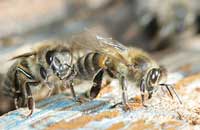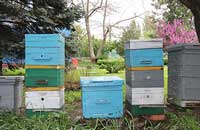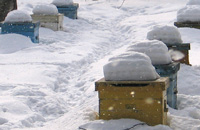УДК 57.022
В пространственной ориентации пчел широко используются пахучие вещества. Способность быстро изменять условный рефлекс на запах источников корма обеспечивает высокую мобильность использования кормовых ресурсов, что получило развитие в процессе приспособления к сезонной смене цветения медоносных растений.
Специфические вещества — феромоны — используют в брачный период матки и трутни. Матки, вылетая на спаривание, по запаху обнаруживают скопления трутней. Пахучие выделения матки, влетающей в скопление трутней, позволяют отличать ее трутням, готовыми к спариванию, от других летающих объектов.
Несмотря на широкое использование в пространственной ориентации пчел пахучих веществ, эти насекомые не ориентируются при подлете к своим жилищам запахом, выделяемым пчелиными семьями.
Ориентация по градиенту пахучего вещества, выделяемого пчелиной семьей, вынуждала бы прилетающих особей совершать круговые облеты жилища, что сопряжено с дополнительными затратами энергии и времени. Это биологически нецелесообразно, поскольку жилище остается на одном месте, а запах семьи меняется в зависимости от запаха потребляемого корма и может сноситься ветром на некоторое расстояние от жилища.
Поэтому естественный отбор благоприятствовал ограничению средств поиска жилища и входа в него по стабильным визуальным ориентирам. Этим врожденная программа реализации хоминга отличается от программы обнаружения по запаху биологически значимых объектов.
Ключевые слова: условные рефлексы, запахи, хеморецепторы, ориентация, трофическое поведение.
Е.К. ЕСЬКОВ, М.Д. ЕСЬКОВА
ФГБОУ ВО «Российский государственный
аграрный заочный университет»
ЛИТЕРАТУРА
1. Вейткявичене Г.Б. Некоторые свойства нейронов дейтоцеребрума пчел на раздражение феромонами пчелиной матки / Химические сигналы животных. — М., 1982.
2. Винников Я.А. Цитологические и молекулярные основы рецепции. — М., 1971.
3. Гери Н.Е. Поведение при спаривании у пчел — новейшие данные // XXII Межд. конгр. по пчеловод- ству. — Бухарест, 1971.
4. Риббандс К.Р. О летной деятельности медоносных пчел / Новое в пчеловодстве. — М., 1958.
5. Esslen J., Kaissling K.E. Zahl und Vertcileng antennaler Sensillen bei dor Honigbiene (Apis mellifera L.) // Zoomorphologie. — 1976. — Bd. 83.
6. Lacher V. Electrophysiologische Untersuchungen an einzeinen Receptoren fur Geruch, Kohlendioxud, Luftfeuchtigkeit und Temperatur auf Antennen der Arbeitsbiene und der Drohne // Zeit. vergl. Physiol. — 1964. — Bd. 48. — №6.
7. Pain J., Ruttner F. Les extraits de glandes mandibulaires des reines d`abeilles attirent les males, lors du vol nuptial // C. R. Acad. Sci. — 1963. — V. 256.
8. Renner M., Veirling G. Die Rolle des Taschendrusenpheromons beim Hochzeitflug der Bienenkonigen // Behav. Scol. Sociobiol. — 1977. — Bd. 2.
9. Riddiford L.M. Antennal protections of saturniid moths — their possible role in olfaction // J. Ins. Physiol. — 1970. — V. 16.
10. Ruttner F., Kaissling K.E. Uber die interspezifische Wirkung des Sexuallockstoffes von Apis mellifera und Apis cerana // Zool vergl. Physiol. — 1968. — Bd. 59.
11. Vareschi E. Duftuterscheidung bei der Honigbiene-Einzelzelt-Ableitungen und Verhaltensreaktionnen // Zeit. vergl. Physiol. — 1971. — Bd. 75. — №2.
СВЕДЕНИЯ ОБ АВТОРАХ:
Еськов Евгений Константинович, д-р. биол. наук, проф., Заслуженный деятель науки и техники РФ, e-mail:
Еськова Майя Дмитриевна, д-р биол. наук, проф.
INNATE AND ACQUIRED REACTIONS OF BEES TO ODORS
E.K. Eskov, М.D. Eskovа
Odorous substances are widely used in the spatial orientation of bees. The ability to change the conditioned reflex quickly to the smell of food sources provides a high mobility of the use of food resources, which was developed within the process of adaptation to the seasonal change in flowering of different melliferous plants. Specific substances — pheromones are used during the mating season by queen bees and drones. The queen bees, flying out to mate, detect clusters of drones by smell. The odoriferous secretions of a queen bee, flying into a cluster of drones, allows mating drones to distinguish the queen bee from other flying objects. Despite the widespread use of odorous substances in the spatial orientation of bees, bees do not orient themselves by the smell emitted by bee colonies when they approach to their homes. Orientation according to the gradient of the odorous substance, emitted by the bee colony, would force arriving bees to make circular flights of the habitation, which is associated with additional expenditures of energy and time. This is biologically impractical, since the dwelling remains in one place, and the smell of the family changes depending on the smell of the consumed food and it can be blown away by the wind at some distance from the dwelling. Therefore, natural selection promoted the limitation of the means of finding home and entering it according to stable visual reference points. This is how the innate program for the implementation of homing differs from the program for detecting biologically significant objects by smell.
Keywords: conditioned reflexes, odors, chemoreceptors, orientation, trophic behavior.

Обхожусь без химпрепаратов…
окт 28, 2014
Изготовление рамок для сотового меда…
март 30, 2015
Перемещение пчел на небольшие расстояния…
окт 28, 2016
Органическое соединение селена при подко…
март 27, 2020
Влияние зимовки на санитарный статус пас…
сен 19, 2015
Монастырские пасеки
фев 4, 2021
Отбор на зимостойкость…
июнь 24, 2015
Получаю экологически чистый мед…
июль 18, 2015
Пасека на шести сотках…
апр 8, 2015
Опыт создания пасек для малоимущего насе…
июль 6, 2016
Поведение пчел-водоносов…
окт 12, 2017
Феромоны медоносной пчелы (2)…
янв 31, 2015
Ройливость местных пчел Алтая …
фев 10, 2020
Стимулирующие подкормки, аэроионизация …
окт 22, 2014
Устройство для сбора прополиса…
мая 25, 2015












 Адрес редакции журнала "Пчеловодство":
Адрес редакции журнала "Пчеловодство":



